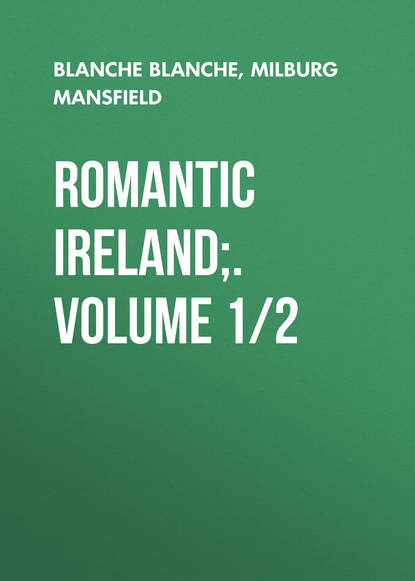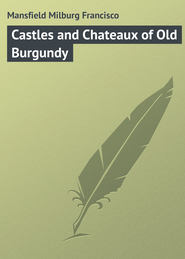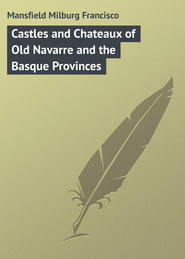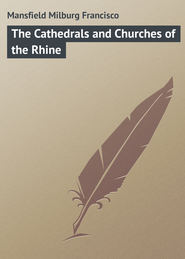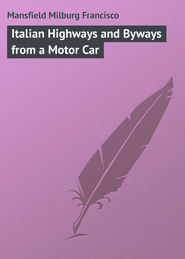По всем вопросам обращайтесь на: info@litportal.ru
(©) 2003-2024.
✖
Romantic Ireland;. Volume 1/2
Настройки чтения
Размер шрифта
Высота строк
Поля
This convent of St. Bridget’s was founded in the fifth century, and its perpetual fire was kept burning until the Reformation. The house where it originally burned is still in evidence, and the cathedral castle and round tower (130 feet in height) form a triumvirate of venerable attractions for all.
To the northward is the Hill of Allen, once crowned, it is said, with three royal residences belonging to the Kings of Leinster.
Wicklow Gap, Glendalough, and the Seven Churches next command attention, as one journeys toward Wicklow town.
Glendalough is thirty miles from Dublin, locally known – and perhaps more widely – as “The Valley of the Seven Churches.” It is the locale of the legend of St. Kevin and Kathleen. The antiquarians have evolved an elaborate thread of legend and tradition concerning the founder of an ancient seat of learning here, but most of them ultimately lost themselves in the intricacies of the web which they wove. Moore, with all his popular and sentimental methods, gave the story – though in this case he has tuned his lute with sadness – much more pleasantly and lucidly, when he told of St. Kevin, who, like St. Anthony, was tempted by the lovely Kathleen, herself so enamoured of him that she was willing even to “lie like a dog at his feet.”
These must have been trying times for St. Kevin, for, to continue Moore’s words, we learn that:
“ ’Twas from Kathleen’s eyes he flew,
Eyes of most unholy blue!
She had loved him well and long,
Wished him hers, nor thought it wrong.
Wheresoe’er the saint would fly,
Still he heard her light foot nigh;
East or west, where’er he turn’d,
Still her eyes before him burned.”
Thirteen hundred years ago, when England was still in a state of modified barbarism, Glendalough was of great importance. It was then that the famous churches, whose ruins still stand to-day, were built. Nearly a thousand years ago, Glendalough had her mansions; her treasure-houses, where the chieftains kept their stores of gold and silver, precious stones, and armour; her famous colleges, to which came students of high lineage from all Western Europe. It became known the world over as a place of sacred associations, great learning, and immense wealth. In the Dark Ages, there could be but one end to a city possessing the last advantage, especially as it was small and easy to besiege. After endless trouble from both Danes and English, the latter nation finally sacked and burned the place in 1398. Glendalough never really lifted up her head again, and is to-day but a hamlet of a few score of cottages. “Dracolatria” – the serpent worship of the Irish pagans – is supposed to have flourished here for ages before the founding of the Seven Churches by St. Kevin; and various legends and traditions, written and oral, are still current with reference to the practice.
Glendalough will endear itself to all who have not hearts of stone. St. Kevin’s ruins are up and down the glen, and his hermit bed still stands in the dug out of the cliffs. That old, old cemetery of Reefert Church, with the thorn-bushes around it, is reckoned among the unique things in Ireland for its tomb of King O’Toole. The present cemetery, all about and within the ruins of the “cathedral,” is also characteristically Irish and charming. There is a monument here which bears the inscription: “We append a record, as far as obtainable, of clergymen buried in this church,” but has not a single name on it. Is this Irish humour, or is it an indication of Irish poverty? The “oldest inhabitant” could not tell the writer.
Hosts of other dead are commemorated in stone, and, moss-covered, the headstones loll here at all angles, as do they elsewhere in Ireland. Just below is St. Kevin’s “kitchen,” with a tower like that of the broken, but still striking, round tower not far beyond. Formerly, it was one of the hermit’s churches (it was never a kitchen, in fact, and no one seems to be able to explain the nomenclature); but it has now been turned into a little museum of decidedly commonplace attractions.
In the church, the “lady-church” of this group of churches, is the reputed burial-place of St. Kevin.
As might be expected, no memorial exists of the holy man but the walls of this tiny church, if even they have genuinely survived his epoch, – the sixth and seventh centuries. No indications point to the exact resting-place of his bones, and the most that is known is that he died at Glendalough in 618 A. D. at the advanced age of 102. “And that is a doubtful fact,” says the local cicerone.
Wicklow itself is a picturesque crescent-shaped coast town. Its name is borne by the Gap at Glendalough, the county, and that famous headland which juts out into St. George’s Channel, as only a few promontories do outside the school geographies.
The ancient Irish called it Gill-Mantain; but, when it fell before the onrush of the Danes, its name was changed to Wykinlo. The chief architectural remains are those of a Franciscan friary of the reign of Henry III., and an Anglo-Norman castle completed in the fourteenth century. Between Wicklow and Arklow lies the celebrated Vale of Avoca. It has been made immortal by the poet Moore; but, though its fame is well deserved, and it is a spot beloved by all who have ever seen it, it is in reality no more beautiful than other similar spots elsewhere.
The Vale of Avoca shares with Killarney, Blarney Castle, and the Giant’s Causeway a popularity which is not equalled by any other of the beauties of Ireland. Here “in this most pleasant vale,” where the Avonbeg joins the Avonmore, is the “Meeting of the Waters.” Moore lavished his choicest phraseology upon its charms; and tourists – since there have been tourists – have devotedly stood by, book in hand, and attempted to fit in the poet’s words with each tree and stone and rivulet. For the most part they have not been successful; and the words the poet sung —
“There is not in the wide world a valley so sweet
As the vale in whose bosom the bright waters meet.
Oh! the last rays of feeling and life must depart,
Ere the bloom of that valley shall fade from my heart.
“Sweet vale of Avoca! how calm could I rest
In thy bosom of shade with the friends I love best,
Where the storms that we feel in this cold world should cease
And our hearts, like the waters, be mingled in peace “ —
might quite as readily have applied to any other spot as fair.
It will never do to disparage Moore’s poetry, and least of all in a chronicle of Irish experiences; but, once and again, an idol does really shatter itself, or at least totters unsteadily on its base; and when one has made the round of all Ireland’s fairest beauties, and heard Moore’s melodies dinned into his ears by importunate touts and mendicants without number, the sentiment is apt to grow thin, and sooner or later the soul rebels. At this point, then, the author’s patience gave out, and so he records his mood, however unseemly it may otherwise appear.
It is indeed a pretty valley, strangely pretty, if you like; and one can hardly remain unmoved and unemotional before its expanse of green, its oaks and beeches, its rocks and rills, its ivies, and more than all else its sunsets. But when one has said with Prince Puckler Muskau – that much-quoted royal German so useful to makers of guide-books – that it is all “exquisitely beautiful,” one has said the first and the last word on the subject. It should be visited and seen in all its beauties; but the experience will not awaken in the hearts of many the emotions which we may presume Moore felt.
Near by is Avondale, the former home of Charles Stewart Parnell. Where the Avonbeg unites with the Avonmore is formed “The Meeting of the Waters.” Many painters have limned its beauties; and, like Killarney, Loch Katrine, and Richmond Vale, on the Thames, replicas of its charms used years ago to find their way in the “table books of art” and “Treasuries,” with which our parents and grandparents used to decorate a small table set before the front window of the parlour.
The part played by the Norman invasion of Ireland has been neglected and overlooked by many in favour of that more portentous invasion of England.
In Ireland the Normans first landed in a little creek on Bannon Bay on the Wexford coast. The advance-guard was composed of thirty knights, sixty men in armour, and three hundred foot-soldiery, under Robert Fitzstephen. This brought on the siege of Wexford, of which the annals, as well as the many remains of ruined castles and churches founded by the invaders, tell.
All this ancient history pales, in the minds of the native bar-parlour frequenters one meets in these parts, before the more vivid, or at least more readily recollected “little affair” of Vinegar Hill and “the Men of ’98,” the site of which, with Enniscorthy, lies just to the northward. A half-century ago historians wrote of this as a “matter yet fresh in the memory of living men,” and the great rebellion – so great at least to Ireland – has been dealt with by writers of all shades of opinion ad infinitum. Even the music-hall songs have perpetuated the belligerent aspect of the inhabitants of Enniscorthy, to say nothing of Killaloe. Nevertheless, the incident of the Norman invasion of Ireland, and the parts played therein by Fitzgerald, Diarmid, the traitorous M’Murrogh, Roderick, Strongbow the Dane, and Prendergast, – named in Irish history as “the faithful Norman,” – presents an inextricable tangle of creeds and races which requires a singularly astute historian to place in line.
It is now seven hundred years since the name of Prendergast was linked with honour and chivalry in Ireland; but something of his earnestness and spirit still lives amongst those who bear his name, if we may judge from the tenor of a modern work by one Prendergast, entitled “The Cromwellian Settlement of Ireland.”
Aubrey de Vere, in his “Lyrical Chronicle of Ireland,” has emblazoned Prendergast’s valour in verse:
THE FAITHFUL NORMAN
“Praise to the valiant and faithful foe!
Give us noble foes, not the friend who lies!
We dread the drugged cup, not the open blow:
We dread the old hate in the new disguise.
“To Ossory’s king they had pledged their word.
He stood in their camp, and their pledge they broke;
Then Maurice the Norman upraised his sword;
The cross on its hilt he kiss’d, and spoke:
“ ‘So long as this sword or this arm hath might,
I swear by the cross which is lord of all,
By the faith and honour of noble and knight,
Who touches you, prince, by this hand shall fall!’
“So side by side through the throng they pass’d;
And Eire gave praise to the just and true.
Brave foe! the past truth heals at last:
There is room in the great heart of Eire for you!”
Round the coast from Wexford to Waterford one passes the famous Tuskar lighthouse, which, with the Saltee light-vessel, thirty miles to the southward, and Carnsore Point, which lies between, forms the turning-point – or the corner which must be rounded – of the vast sea-borne traffic bound up the St. George’s Channel from the Atlantic.
The chief historical monument of Waterford, with the exception of the reconstructed castle and Ballinakil House, the last halting-place of the fleeing Stuart king, is a squat circular building known as “Reginald’s Tower.” It sits close to the quayside, and is by far the most notable landmark, viewed from either sea or land, which the city possesses. Its erection is credited to Reginald, the Dane, some nine hundred and odd years ago. Kingsley, in “Hereward the Wake,” weaves much of romance around its sturdy walls.
In 1171, when Strongbow and Raymond le Gros took Waterford, it was inhabited by Danes, who, with the exception of the prince of the Danes and a few others, were put to death. It was here that Earl Strongbow was married to Eva, daughter of the King of Leinster; and here, too, that Henry II. first landed in Ireland to take possession of the country which had been granted to him by the bull of Pope Adrian.
Near Waterford is Dungarvan, once a fishing-town of considerable importance. Its fishermen were bold, and went far out to sea, for it was a Dungarvan man who was captured and made to act as pilot by the corsairs of Algiers, who sacked the town of Baltimore, close to Cape Clear, in 1631, when all the inhabitants were killed or carried off into slavery. A curious page of the Irish history, and one which reads more like romantic legend than fact. This man’s name was Hackett, and the story tells that his service to the Algerians was repaid, by his outraged countrymen, with the halter.
Between Cork – with its poetic associations of the Shandon Bells, the river Lee, and of Blarney Castle – and the glens and vales of Wicklow, there is no spot to equal in picturesqueness and romantic environment the celebrated valley of the Blackwater, which, forming a broad estuary, mingles with the waters of the Atlantic at Youghal Harbour. The great beauties of the Blackwater only unfold themselves as one ascends the stream some twenty miles above Youghal, but the whole lower river has a placid charm which is quite inexplicable.
For what is Youghal famous, say the untravelled? In matters Irish, for many things, but the most lively interest is awakened by the recollection of Myrtle Grove, the one-time residence of Sir Walter Raleigh, Governor of the Virginia Colony in the New World, who, though he had never been there, is popularly supposed to have introduced its tobacco into Great Britain. As a matter of fact, he did not, but some one of his understudies did; and it was at Myrtle Grove that his servant sought to save him from incineration by deluging him with water while he was smoking his favourite pipe. There is doubtless somewhat of legend about this; and the incident has been worn threadbare in its use by an enterprising firm of tobacco manufacturers; but, since Myrtle Grove really exists, and Raleigh really lived there, there is some excuse for it.
It was here, too that the potato, since become a too staple article of diet, was first introduced to Irish soil.
Truly Raleigh is entitled to a reputation as a true benefactor of the race exceeding that due to his reputed chivalry to Queen Elizabeth. Without potatoes and tobacco, what might not have happened to the British race long before now?
To the northward is the Hill of Allen, once crowned, it is said, with three royal residences belonging to the Kings of Leinster.
Wicklow Gap, Glendalough, and the Seven Churches next command attention, as one journeys toward Wicklow town.
Glendalough is thirty miles from Dublin, locally known – and perhaps more widely – as “The Valley of the Seven Churches.” It is the locale of the legend of St. Kevin and Kathleen. The antiquarians have evolved an elaborate thread of legend and tradition concerning the founder of an ancient seat of learning here, but most of them ultimately lost themselves in the intricacies of the web which they wove. Moore, with all his popular and sentimental methods, gave the story – though in this case he has tuned his lute with sadness – much more pleasantly and lucidly, when he told of St. Kevin, who, like St. Anthony, was tempted by the lovely Kathleen, herself so enamoured of him that she was willing even to “lie like a dog at his feet.”
These must have been trying times for St. Kevin, for, to continue Moore’s words, we learn that:
“ ’Twas from Kathleen’s eyes he flew,
Eyes of most unholy blue!
She had loved him well and long,
Wished him hers, nor thought it wrong.
Wheresoe’er the saint would fly,
Still he heard her light foot nigh;
East or west, where’er he turn’d,
Still her eyes before him burned.”
Thirteen hundred years ago, when England was still in a state of modified barbarism, Glendalough was of great importance. It was then that the famous churches, whose ruins still stand to-day, were built. Nearly a thousand years ago, Glendalough had her mansions; her treasure-houses, where the chieftains kept their stores of gold and silver, precious stones, and armour; her famous colleges, to which came students of high lineage from all Western Europe. It became known the world over as a place of sacred associations, great learning, and immense wealth. In the Dark Ages, there could be but one end to a city possessing the last advantage, especially as it was small and easy to besiege. After endless trouble from both Danes and English, the latter nation finally sacked and burned the place in 1398. Glendalough never really lifted up her head again, and is to-day but a hamlet of a few score of cottages. “Dracolatria” – the serpent worship of the Irish pagans – is supposed to have flourished here for ages before the founding of the Seven Churches by St. Kevin; and various legends and traditions, written and oral, are still current with reference to the practice.
Glendalough will endear itself to all who have not hearts of stone. St. Kevin’s ruins are up and down the glen, and his hermit bed still stands in the dug out of the cliffs. That old, old cemetery of Reefert Church, with the thorn-bushes around it, is reckoned among the unique things in Ireland for its tomb of King O’Toole. The present cemetery, all about and within the ruins of the “cathedral,” is also characteristically Irish and charming. There is a monument here which bears the inscription: “We append a record, as far as obtainable, of clergymen buried in this church,” but has not a single name on it. Is this Irish humour, or is it an indication of Irish poverty? The “oldest inhabitant” could not tell the writer.
Hosts of other dead are commemorated in stone, and, moss-covered, the headstones loll here at all angles, as do they elsewhere in Ireland. Just below is St. Kevin’s “kitchen,” with a tower like that of the broken, but still striking, round tower not far beyond. Formerly, it was one of the hermit’s churches (it was never a kitchen, in fact, and no one seems to be able to explain the nomenclature); but it has now been turned into a little museum of decidedly commonplace attractions.
In the church, the “lady-church” of this group of churches, is the reputed burial-place of St. Kevin.
As might be expected, no memorial exists of the holy man but the walls of this tiny church, if even they have genuinely survived his epoch, – the sixth and seventh centuries. No indications point to the exact resting-place of his bones, and the most that is known is that he died at Glendalough in 618 A. D. at the advanced age of 102. “And that is a doubtful fact,” says the local cicerone.
Wicklow itself is a picturesque crescent-shaped coast town. Its name is borne by the Gap at Glendalough, the county, and that famous headland which juts out into St. George’s Channel, as only a few promontories do outside the school geographies.
The ancient Irish called it Gill-Mantain; but, when it fell before the onrush of the Danes, its name was changed to Wykinlo. The chief architectural remains are those of a Franciscan friary of the reign of Henry III., and an Anglo-Norman castle completed in the fourteenth century. Between Wicklow and Arklow lies the celebrated Vale of Avoca. It has been made immortal by the poet Moore; but, though its fame is well deserved, and it is a spot beloved by all who have ever seen it, it is in reality no more beautiful than other similar spots elsewhere.
The Vale of Avoca shares with Killarney, Blarney Castle, and the Giant’s Causeway a popularity which is not equalled by any other of the beauties of Ireland. Here “in this most pleasant vale,” where the Avonbeg joins the Avonmore, is the “Meeting of the Waters.” Moore lavished his choicest phraseology upon its charms; and tourists – since there have been tourists – have devotedly stood by, book in hand, and attempted to fit in the poet’s words with each tree and stone and rivulet. For the most part they have not been successful; and the words the poet sung —
“There is not in the wide world a valley so sweet
As the vale in whose bosom the bright waters meet.
Oh! the last rays of feeling and life must depart,
Ere the bloom of that valley shall fade from my heart.
“Sweet vale of Avoca! how calm could I rest
In thy bosom of shade with the friends I love best,
Where the storms that we feel in this cold world should cease
And our hearts, like the waters, be mingled in peace “ —
might quite as readily have applied to any other spot as fair.
It will never do to disparage Moore’s poetry, and least of all in a chronicle of Irish experiences; but, once and again, an idol does really shatter itself, or at least totters unsteadily on its base; and when one has made the round of all Ireland’s fairest beauties, and heard Moore’s melodies dinned into his ears by importunate touts and mendicants without number, the sentiment is apt to grow thin, and sooner or later the soul rebels. At this point, then, the author’s patience gave out, and so he records his mood, however unseemly it may otherwise appear.
It is indeed a pretty valley, strangely pretty, if you like; and one can hardly remain unmoved and unemotional before its expanse of green, its oaks and beeches, its rocks and rills, its ivies, and more than all else its sunsets. But when one has said with Prince Puckler Muskau – that much-quoted royal German so useful to makers of guide-books – that it is all “exquisitely beautiful,” one has said the first and the last word on the subject. It should be visited and seen in all its beauties; but the experience will not awaken in the hearts of many the emotions which we may presume Moore felt.
Near by is Avondale, the former home of Charles Stewart Parnell. Where the Avonbeg unites with the Avonmore is formed “The Meeting of the Waters.” Many painters have limned its beauties; and, like Killarney, Loch Katrine, and Richmond Vale, on the Thames, replicas of its charms used years ago to find their way in the “table books of art” and “Treasuries,” with which our parents and grandparents used to decorate a small table set before the front window of the parlour.
The part played by the Norman invasion of Ireland has been neglected and overlooked by many in favour of that more portentous invasion of England.
In Ireland the Normans first landed in a little creek on Bannon Bay on the Wexford coast. The advance-guard was composed of thirty knights, sixty men in armour, and three hundred foot-soldiery, under Robert Fitzstephen. This brought on the siege of Wexford, of which the annals, as well as the many remains of ruined castles and churches founded by the invaders, tell.
All this ancient history pales, in the minds of the native bar-parlour frequenters one meets in these parts, before the more vivid, or at least more readily recollected “little affair” of Vinegar Hill and “the Men of ’98,” the site of which, with Enniscorthy, lies just to the northward. A half-century ago historians wrote of this as a “matter yet fresh in the memory of living men,” and the great rebellion – so great at least to Ireland – has been dealt with by writers of all shades of opinion ad infinitum. Even the music-hall songs have perpetuated the belligerent aspect of the inhabitants of Enniscorthy, to say nothing of Killaloe. Nevertheless, the incident of the Norman invasion of Ireland, and the parts played therein by Fitzgerald, Diarmid, the traitorous M’Murrogh, Roderick, Strongbow the Dane, and Prendergast, – named in Irish history as “the faithful Norman,” – presents an inextricable tangle of creeds and races which requires a singularly astute historian to place in line.
It is now seven hundred years since the name of Prendergast was linked with honour and chivalry in Ireland; but something of his earnestness and spirit still lives amongst those who bear his name, if we may judge from the tenor of a modern work by one Prendergast, entitled “The Cromwellian Settlement of Ireland.”
Aubrey de Vere, in his “Lyrical Chronicle of Ireland,” has emblazoned Prendergast’s valour in verse:
THE FAITHFUL NORMAN
“Praise to the valiant and faithful foe!
Give us noble foes, not the friend who lies!
We dread the drugged cup, not the open blow:
We dread the old hate in the new disguise.
“To Ossory’s king they had pledged their word.
He stood in their camp, and their pledge they broke;
Then Maurice the Norman upraised his sword;
The cross on its hilt he kiss’d, and spoke:
“ ‘So long as this sword or this arm hath might,
I swear by the cross which is lord of all,
By the faith and honour of noble and knight,
Who touches you, prince, by this hand shall fall!’
“So side by side through the throng they pass’d;
And Eire gave praise to the just and true.
Brave foe! the past truth heals at last:
There is room in the great heart of Eire for you!”
Round the coast from Wexford to Waterford one passes the famous Tuskar lighthouse, which, with the Saltee light-vessel, thirty miles to the southward, and Carnsore Point, which lies between, forms the turning-point – or the corner which must be rounded – of the vast sea-borne traffic bound up the St. George’s Channel from the Atlantic.
The chief historical monument of Waterford, with the exception of the reconstructed castle and Ballinakil House, the last halting-place of the fleeing Stuart king, is a squat circular building known as “Reginald’s Tower.” It sits close to the quayside, and is by far the most notable landmark, viewed from either sea or land, which the city possesses. Its erection is credited to Reginald, the Dane, some nine hundred and odd years ago. Kingsley, in “Hereward the Wake,” weaves much of romance around its sturdy walls.
In 1171, when Strongbow and Raymond le Gros took Waterford, it was inhabited by Danes, who, with the exception of the prince of the Danes and a few others, were put to death. It was here that Earl Strongbow was married to Eva, daughter of the King of Leinster; and here, too, that Henry II. first landed in Ireland to take possession of the country which had been granted to him by the bull of Pope Adrian.
Near Waterford is Dungarvan, once a fishing-town of considerable importance. Its fishermen were bold, and went far out to sea, for it was a Dungarvan man who was captured and made to act as pilot by the corsairs of Algiers, who sacked the town of Baltimore, close to Cape Clear, in 1631, when all the inhabitants were killed or carried off into slavery. A curious page of the Irish history, and one which reads more like romantic legend than fact. This man’s name was Hackett, and the story tells that his service to the Algerians was repaid, by his outraged countrymen, with the halter.
Between Cork – with its poetic associations of the Shandon Bells, the river Lee, and of Blarney Castle – and the glens and vales of Wicklow, there is no spot to equal in picturesqueness and romantic environment the celebrated valley of the Blackwater, which, forming a broad estuary, mingles with the waters of the Atlantic at Youghal Harbour. The great beauties of the Blackwater only unfold themselves as one ascends the stream some twenty miles above Youghal, but the whole lower river has a placid charm which is quite inexplicable.
For what is Youghal famous, say the untravelled? In matters Irish, for many things, but the most lively interest is awakened by the recollection of Myrtle Grove, the one-time residence of Sir Walter Raleigh, Governor of the Virginia Colony in the New World, who, though he had never been there, is popularly supposed to have introduced its tobacco into Great Britain. As a matter of fact, he did not, but some one of his understudies did; and it was at Myrtle Grove that his servant sought to save him from incineration by deluging him with water while he was smoking his favourite pipe. There is doubtless somewhat of legend about this; and the incident has been worn threadbare in its use by an enterprising firm of tobacco manufacturers; but, since Myrtle Grove really exists, and Raleigh really lived there, there is some excuse for it.
It was here, too that the potato, since become a too staple article of diet, was first introduced to Irish soil.
Truly Raleigh is entitled to a reputation as a true benefactor of the race exceeding that due to his reputed chivalry to Queen Elizabeth. Without potatoes and tobacco, what might not have happened to the British race long before now?





